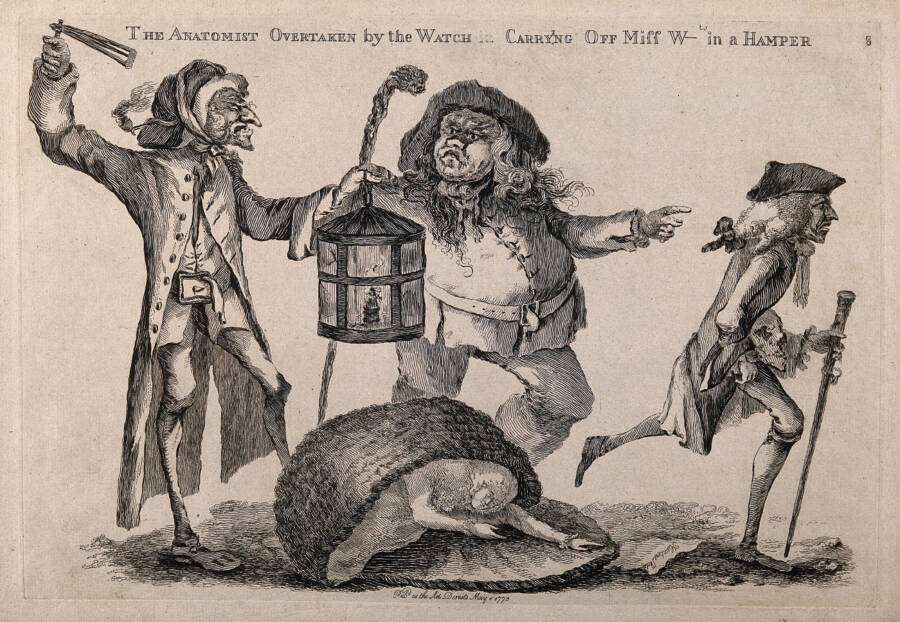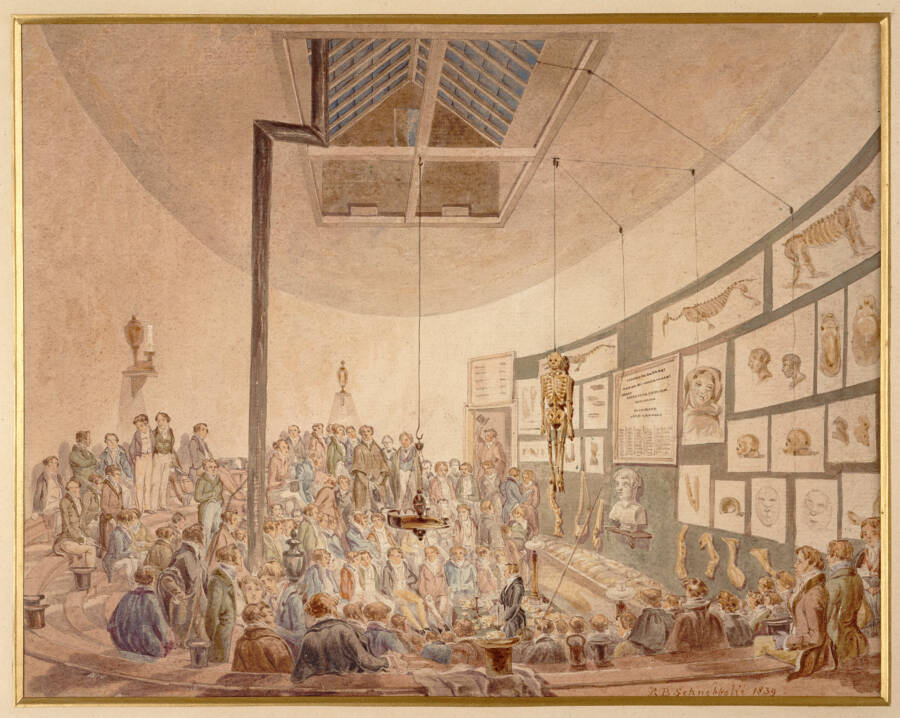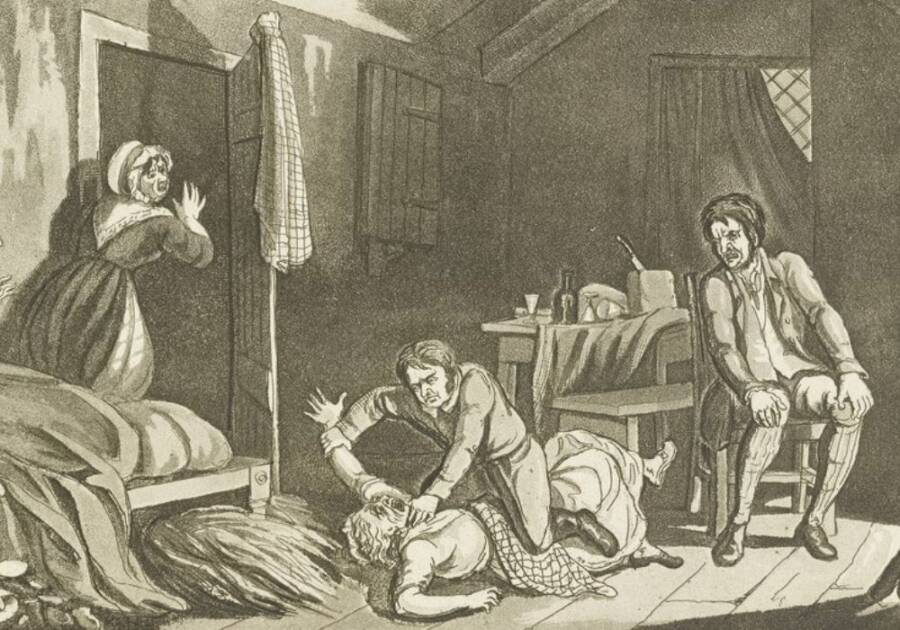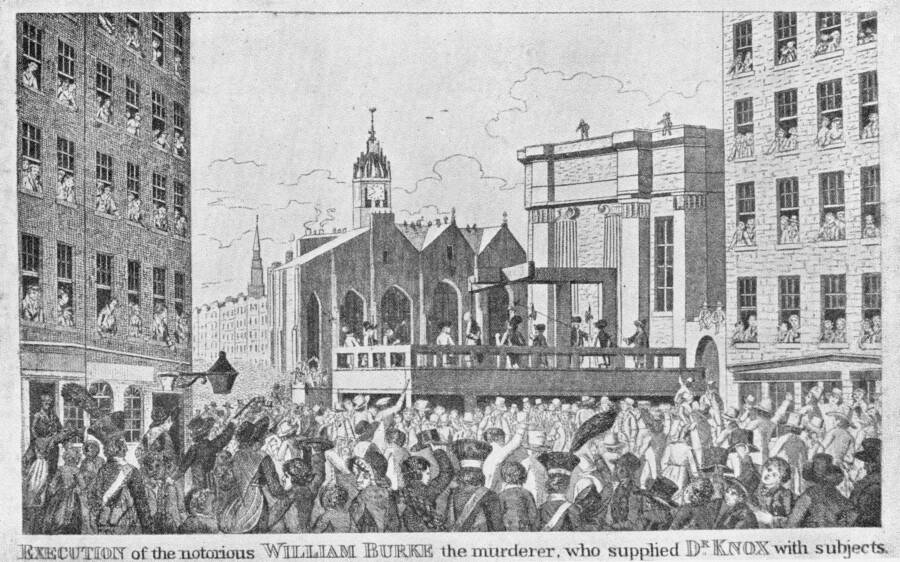During an 11-month period between 1827 and 1828, William Burke and William Hare murdered at least 16 people in Edinburgh and sold their corpses to a surgeon at a local anatomy school in a macabre money-making scheme.
In 19th-century Scotland, grave robbery was a lucrative trade — but a notorious duo known as Burke and Hare took the crime a step further. Rather than stealing bodies from coffins to sell to anatomy schools, the men turned to murder for a steady supply of corpses.

Public DomainPortraits of William Burke (left) and William Hare (right).
Between 1827 and 1828, William Burke and William Hare killed at least 16 people in Edinburgh. They then sold their victims’ bodies to Dr. Robert Knox, a surgeon at a local school of anatomy, for between seven and 10 pounds each. Altogether, the men brought in some $24,000 in today’s currency.
Their fearsome crime spree finally came to an end in November 1828 when lodgers at Burke’s boarding house discovered the body of the men’s final victim hidden beneath straw bedding and alerted the police. Hare agreed to testify against Burke in exchange for immunity — and Burke was quickly sentenced to death.
Then, in the ultimate twist of fate, William Burke’s corpse was donated to medical science.
How Burke And Hare Became 19th-Century Edinburgh’s Deadliest Duo
William Burke and William Hare both hailed from Ireland, but they moved to Edinburgh in the early 1800s to help build the Union Canal. Hare eventually became the keeper of a boarding house in the West Port area of the city along with his partner, Margaret Laird. In 1827, Burke moved onto the same street with a woman named Helen McDougal, and he and Hare became fast friends.
On Nov. 29, 1827, a man known as Old Donald who had been living at Hare’s boarding house died. At the time, he still owed four pounds in rent — and Hare was determined to get his money.
In Edinburgh (as elsewhere in Britain), anatomists required a steady supply of human cadavers to dissect for the purposes of research and teaching. Because physicians had limited access to fresh specimens, they purchased bodies of the recently deceased from whoever was selling. Most notoriously, grave robbers, or “body snatchers,” infiltrated churchyards, disinterred corpses, and sold them to doctors.

Wellcome Collection, LondonA “resurrectionist” caught in the act of stealing a cadaver.
Hare’s idea was to sell Old Donald to a local anatomist to recoup his debt. He shared the plan with Burke, who agreed to take part in it. Before the elderly man was buried, the duo removed his body from his wooden coffin and replaced it with bark. They then sold the corpse to a surgeon named Dr. Robert Knox for seven pounds and 10 shillings. In today’s currency, that would be close to $1,000.
The sale was so profitable that Burke and Hare had no qualms about acquiring more corpses for Knox — but this time, they didn’t wait for someone to die.
Inside Scotland’s West Port Murders
In early 1828, another one of Hare’s boarders, a man named Joseph, fell ill. Instead of waiting to see if he would get better, Burke and Hare simply decided to kill him so they could sell his body. They plied him with whiskey until he was too inebriated to fight back and smothered him to death so they wouldn’t leave any trace of violence behind. This method would later become known as “burking.”

Wellcome Collection, LondonAn 1829 political cartoon by William Heath that depicts Sir Robert Peele and the Duke of Wellington “burking” Old Mrs. Constitution.
In his alleged confessions, published in an 1829 issue of the Caledonian Mercury, William Burke described in grisly detail the exact way in which he and Hare murdered their victims:
“By suffocation. We made the persons drunk, and then suffocated them by holding the nostrils and mouth, and getting on the body. Sometimes I held the mouth and nose, while Hare went upon the body; and sometimes Hare held the mouth and nose, while I placed myself on the body.”
Over a span of 11 months, Burke and Hare murdered at least 16 people in their macabre scheme. Many of their victims were sex workers or wayfaring travelers — people they didn’t think would be missed if they suddenly vanished.
The men were ruthless and seemingly didn’t care who they killed as long as they could turn a hefty profit. They murdered a relative of Burke’s partner, an elderly woman and her grandson, and even a popular street entertainer known as “Daft Jamie.”
The National Galleries Scotland reports that Daft Jamie’s real name was James Wilson. He was likely a savant, as he was known for being able to determine what day of the week any date in history fell on.

Wellcome Collection, London A depiction of a 19th-century anatomy lecture in London. Some of the bodies Burke and Hare sold to Dr. Robert Knox would have been used similarly.
In his confessions, William Burke claimed that Jamie was killed in Hare’s boarding house in 1828, saying, “Hare began the struggle with him, and they fell and rolled together on the ground; then I went to Hare’s assistance, and we at length finished him, though with much difficulty.”
However, Burke and Hare’s most notorious murder was that of Marjory Campbell Docherty, their final victim.
The Murder Of Marjory Campbell Docherty
Burke and Hare might have kept peddling their ill-gotten cadavers for years were it not for the events of Oct. 31, 1828.
That day, Marjory Campbell Docherty (also called Margaret, Madgy, or Mary by various sources from the time) was visiting Edinburgh from Glasgow in search of her son. At some point, she ran into William Burke, who offered her a bed and a meal that evening. Docherty accepted.
At the time, Burke and McDougal had two other lodgers named James and Ann Gray. Burke reportedly sent the Grays to Hare’s house for the evening, and when the couple returned the next day, they were told not to enter a spare room where some of their belongings were. They went into the room anyway when they were left alone — and found Docherty’s dead body hidden away beneath straw bedding.

Public DomainAn 1829 etching of the murder of Marjory Campbell Docherty.
McDougal reportedly offered the Grays 10 pounds not to say anything, but the frightened couple immediately went to the police, who rushed to Burke’s boarding house. By then, Burke and Hare had removed Docherty’s corpse, so there was no physical evidence left for prosecutors to use against the men.
Instead, investigators convinced Hare to turn on his partner in crime.
The Sensational Trial Of Burke And Hare
The police arrested William Burke, William Hare, Margaret Laird, and Helen McDougal for murder in November 1828. However, since there was no physical evidence connecting any of them to a crime scene, prosecutors weren’t sure they could secure a conviction. (It remains uncertain how much Laird and McDougal knew about their partners’ misdeeds and to what extent they participated in them.)
With no other options, Scotland’s Lord Advocate, Sir William Rae, approached Hare with a deal. He would grant Hare and Laird immunity if they agreed to testify against Burke and McDougal. Hare quickly accepted, detailing the many murders that he and Burke had committed.
William Burke and Helen McDougal’s trial began on Christmas Eve 1828. McDougal was acquitted, but Burke was convicted of murder.

Public DomainAn 1829 depiction of William Burke’s execution.
McDougal, Laird, and Hare skipped town, and they all but vanished from the historical record. Dr. Robert Knox avoided prosecution after Burke testified that the surgeon had no idea the corpses he was purchasing were murder victims, but his reputation was in shambles, so he had to leave Edinburgh as well. He moved to London in an attempt to salvage his career.
William Burke was hanged on Jan. 5, 1829, before an estimated 25,000 spectators. His body was donated to an anatomy school, and medical students reportedly took pieces of his skin as souvenirs and turned them into book bindings. His skeleton is still on display at Surgeon’s Hall in Edinburgh to this day, a fitting end for the man who made such a grisly mark on the city’s history.
After reading about the crimes of Burke and Hare, go inside the legend of Sawney Bean, the 16th-century Scottish cannibal. Then, learn about Ed Gein, the grave robber and serial killer who made furniture out of human body parts.





